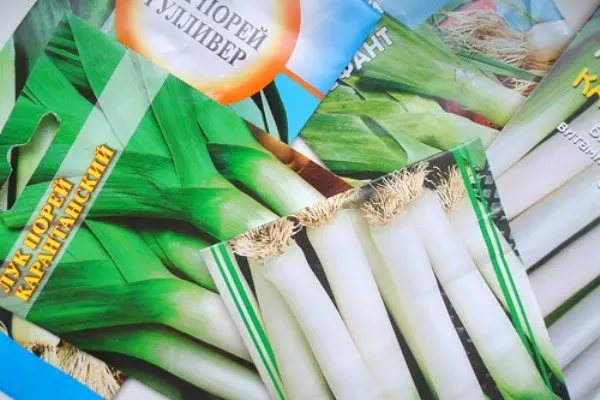Onions have many varieties, one of which is the leek. This is one of the fragrant and very useful varieties. This article will focus on its variety – the Karantan leek.
Variety description
Leek varieties Karantansky refers to European winter-hardy plants. This is a late look. From the moment of planting to harvest, you must wait at least five months. Sometimes this time period can be delayed up to seven months. The growing season lasts an average of about 180 (125-200) days. Gives fresh greens until the time of the first sub-zero temperatures. The plant forms a false short stem, which grows up to 20 cm in height. The stem is cylindrical and the leaves are fan-shaped on it. The thickness of the middle part of the stem varies between 4-6 cm.
The leaves are dark green in color and richly covered with a waxy coating. They are spreading and quite tightly adjacent to one another. Internodes are short. The bulb itself is white, but gradually turns green towards the leaf area. The bulb is small in size.
You can start harvesting in the second part of September and until October. Unexpected frosts this time will not have a negative effect on the onion. Yield from one m2 up to 4 kg. One plant reaches a weight of 200 to 325 g.

Variety Karantansky has very good taste qualities. It tastes semi-sharp. Onions are used fresh in salads. Good winter hardiness and keeping quality of the plant are described. In the presence of snow, it tolerates cold well. If there is not enough snow, then the onion should be covered for the winter to prevent its death.
Features of agricultural technology
Growing Carentan leek has its own characteristics. Sowing of its seeds is carried out in early March, it is not recommended to do this before. Seeds remain viable for three years. It should be remembered that a flower shoot with seeds is formed only the next year. In this regard, the reproduction of plants is carried out only after winter. Sowing seeds in the greenhouse is carried out 50 or 60 days before planting in open ground.
Rules for planting seeds:
- before sowing, the seeds must be soaked in water at a temperature of 50 degrees Celsius for three days;
- it is best to plant in the ground to a depth of about 2 cm;
- between the landing lines should be left about 4-5 cm of free space.
The temperature regime in the greenhouse for the period of seed germination should be about + 20-22 ° C. Subject to these rules, the first shoots will appear on the 10-15th day. As soon as the first shoots appear, the temperature in the greenhouse during the day is reduced to + 18-20 ° C, and at night to + 10-12 ° C.

During the cultivation of seedlings, two liquid top dressings are carried out with ammonium nitrate and superphosphate.
Seedlings are ready for planting in the ground when they have the first 3-4 true leaves, and the diameter of the stem itself should vary within 6-8 mm. Before transplanting, seedlings are watered abundantly.
Approximately three months after sowing, seedlings can be transferred to a permanent place of growth. This usually happens in early June. Seedlings are planted in grooves and fertilized over the next two months. Top dressing should be carried out with a fertile substrate, which has a high level of the following elements: potassium, nitrogen and phosphorus.
Planting seedlings is carried out as follows:
- dig the soil well;
- the distance between the grooves should be at least 30 cm;
- the depth of the grooves is 10 cm;
- the distance between plants is best kept within 15-20 cm. This parameter is derived taking into account the size of the yield. You can also plant at a distance of up to 10 cm, but then in August it will be necessary to thin out one plant;
- seedlings are planted in two-line ribbons according to the scheme 25×50 and 30×60 cm or in single-line rows;
- the planting rate for this plant is no more than 25 seedlings per 1 m2.
Before planting the bulbs in open ground, their roots are shortened by about 3 cm, and the stem length is shortened by 1/3 of the leaf length. This will significantly increase the yield.

Moist and rich floodplain soils are best suited for plant growth, but acidic soils are not suitable in this case. In the case of acidic soils, before planting the seeds, they must first be treated with lime. The plant is very demanding on light, so it should be planted in places with good access to sunlight. You can not plant onions after garlic, carrots, cucumbers or other types of onions. It grows well after cabbage, tomato, peas, green manure and beans.
Leek care is carried out similarly to onions:
- hilling during the growing season is carried out at least three times;
- before hilling, ash is added at the rate of one glass per 1 m2 of beds;
- periodic watering. Especially often you need to water during the second growing season. Watered once every 5 days at the rate of 10 liters of water per 1 m2;
- chemical treatment should not be carried out;
- Top dressing is done at least 4 times. It is necessary to alternate fertilizing with organic and mineral fertilizers. It is good to feed with bird droppings and mullein;
- after feeding, the onions are watered, and then the aisles are loosened;
- in autumn, hilling is carried out with peat or soil to a height of 20-30 cm;
- harvesting should be completed before frost.
Knowing the rules of agricultural technology, you can easily grow Karantansky leeks.
Video “Growing leeks”
This video shows you how to grow and harvest a good crop of leeks. Soil preparation, sowing, care and harvesting.









